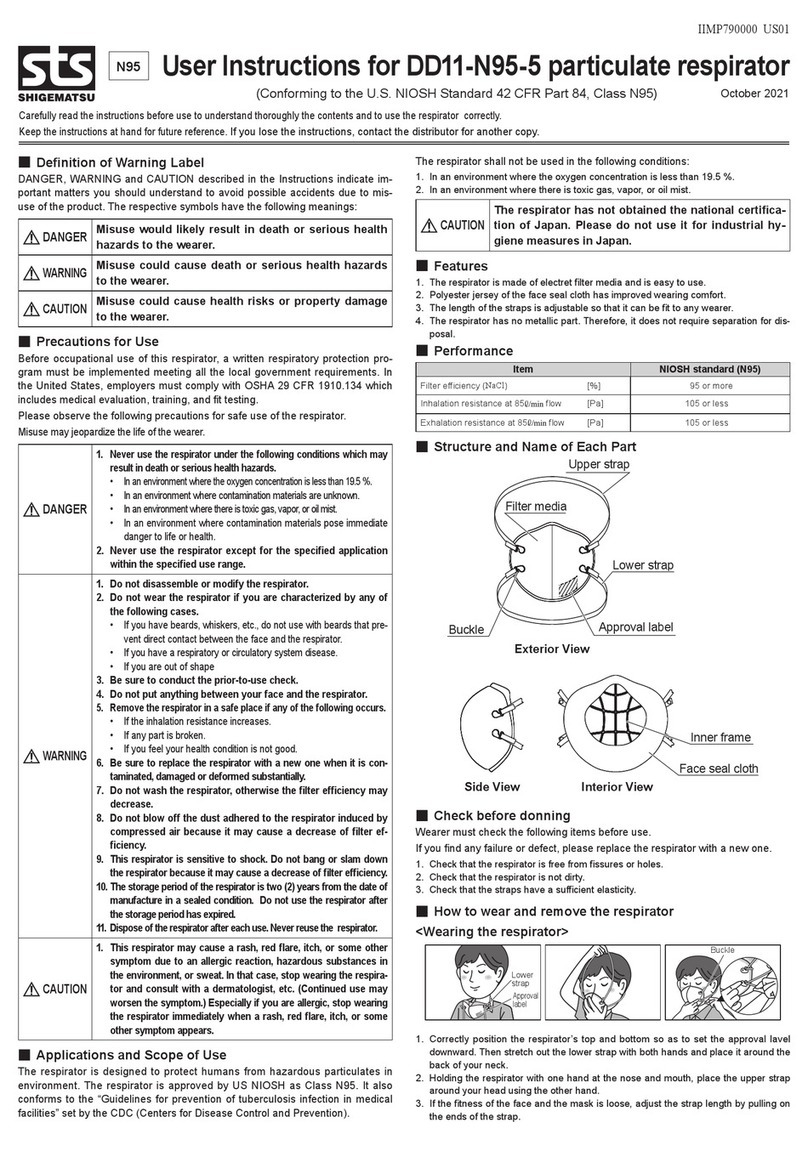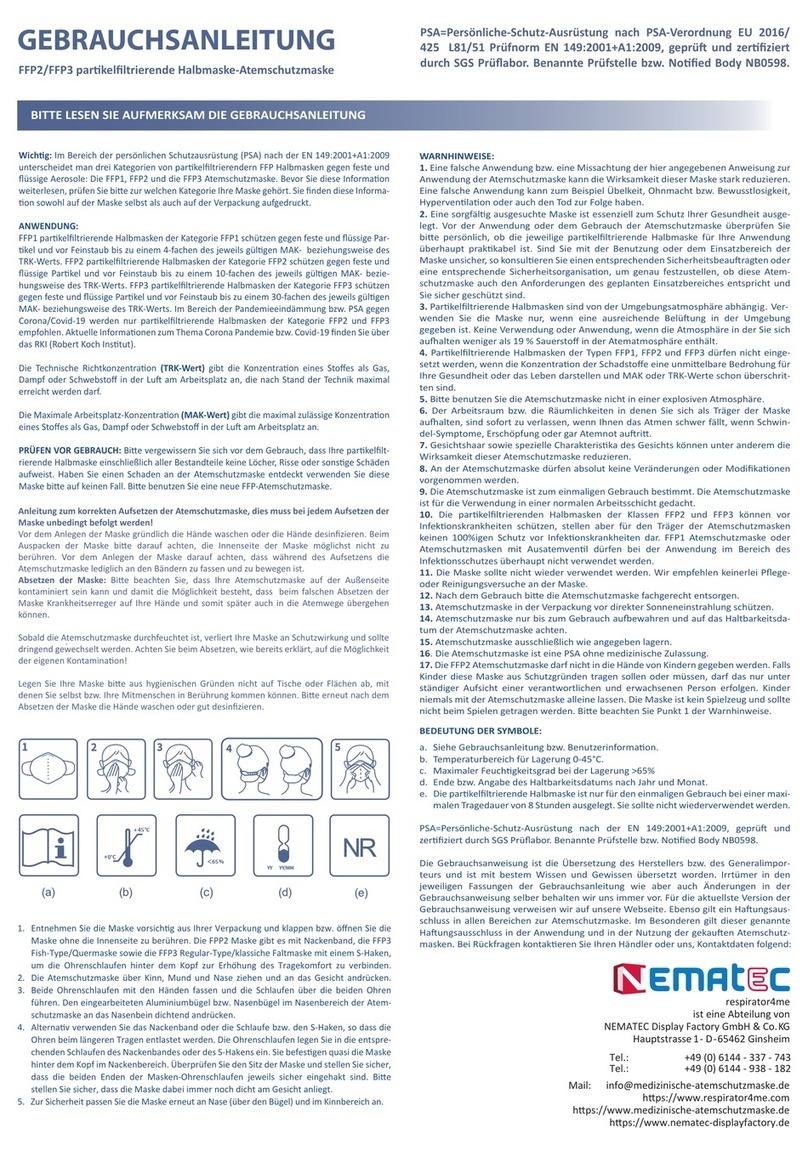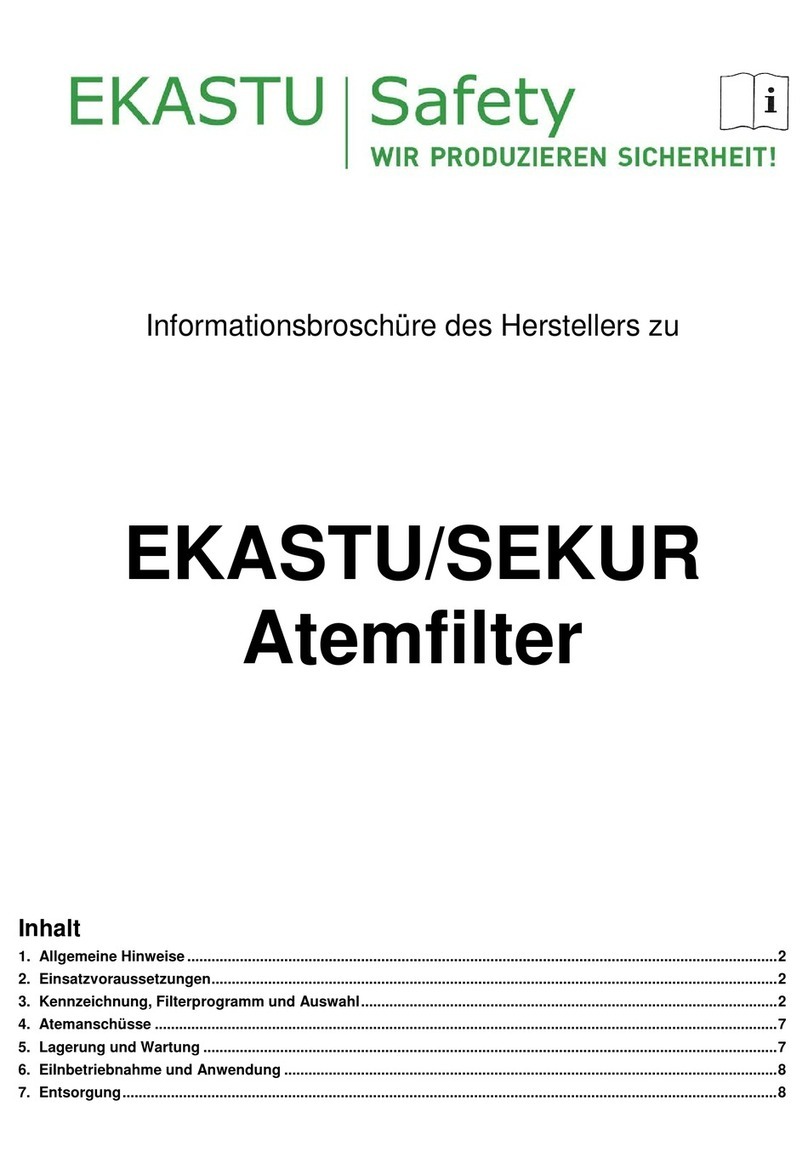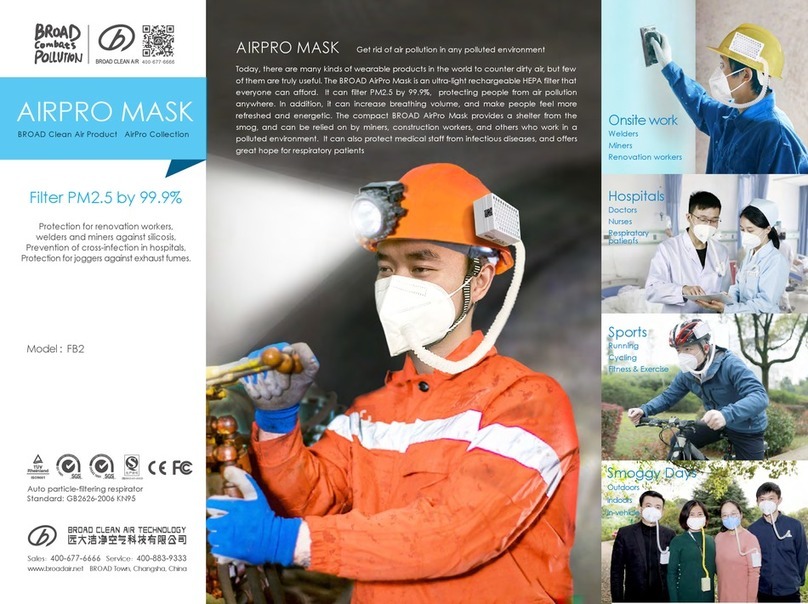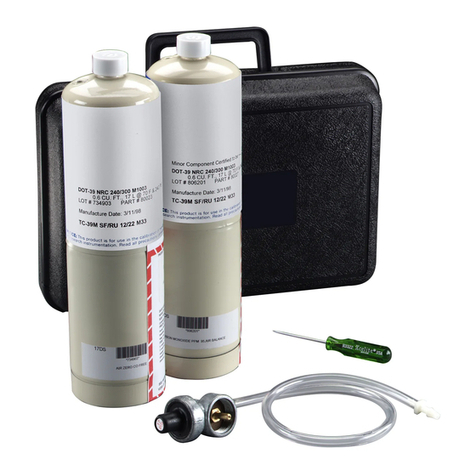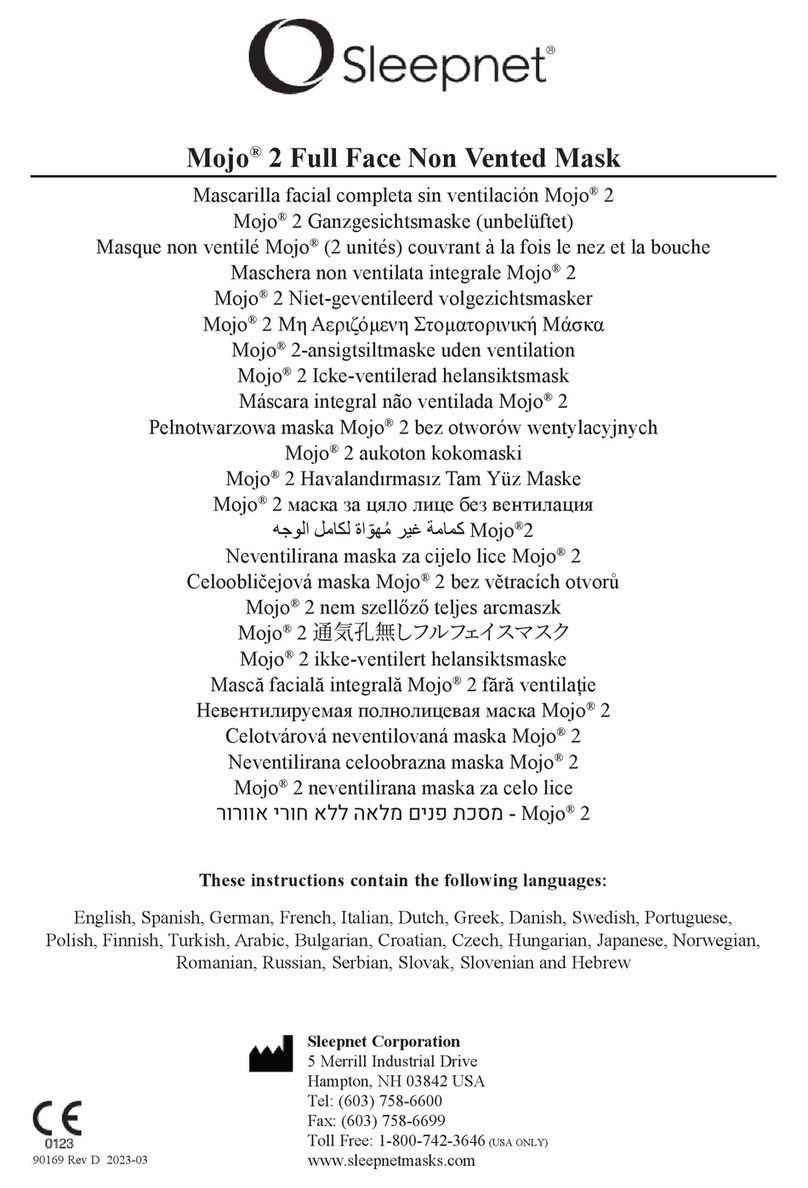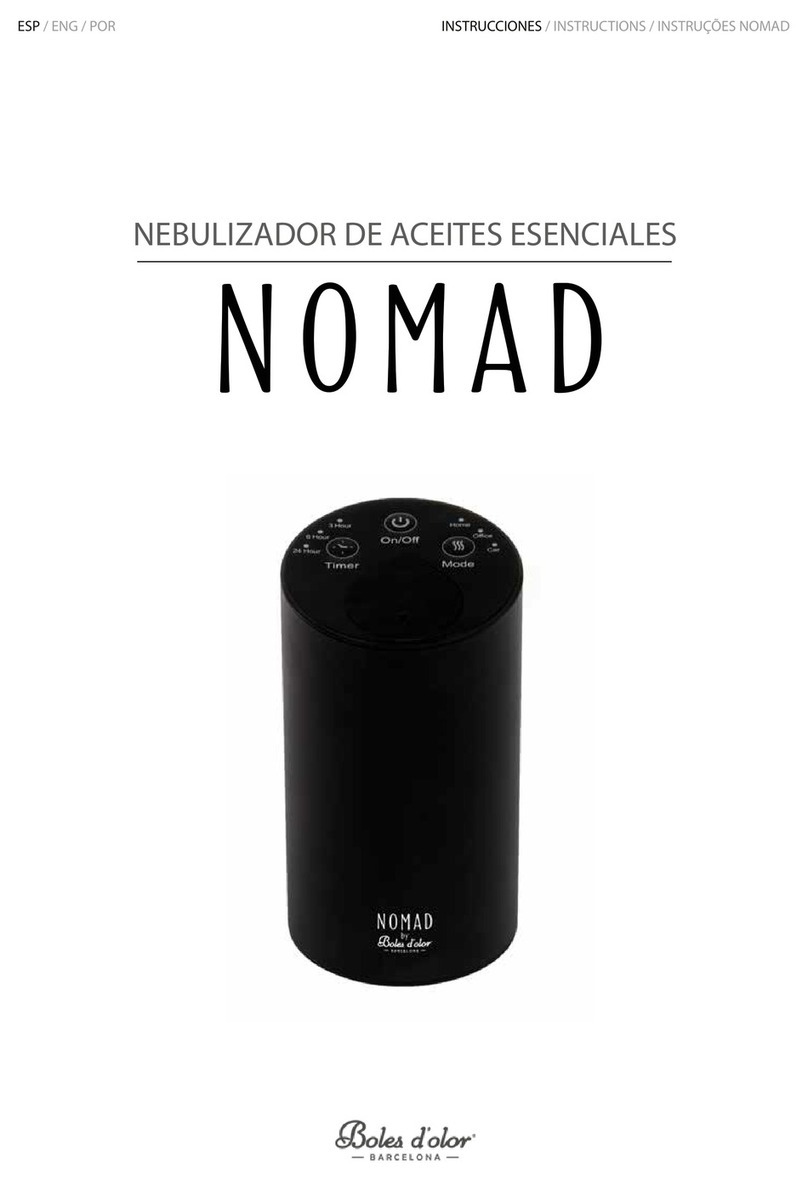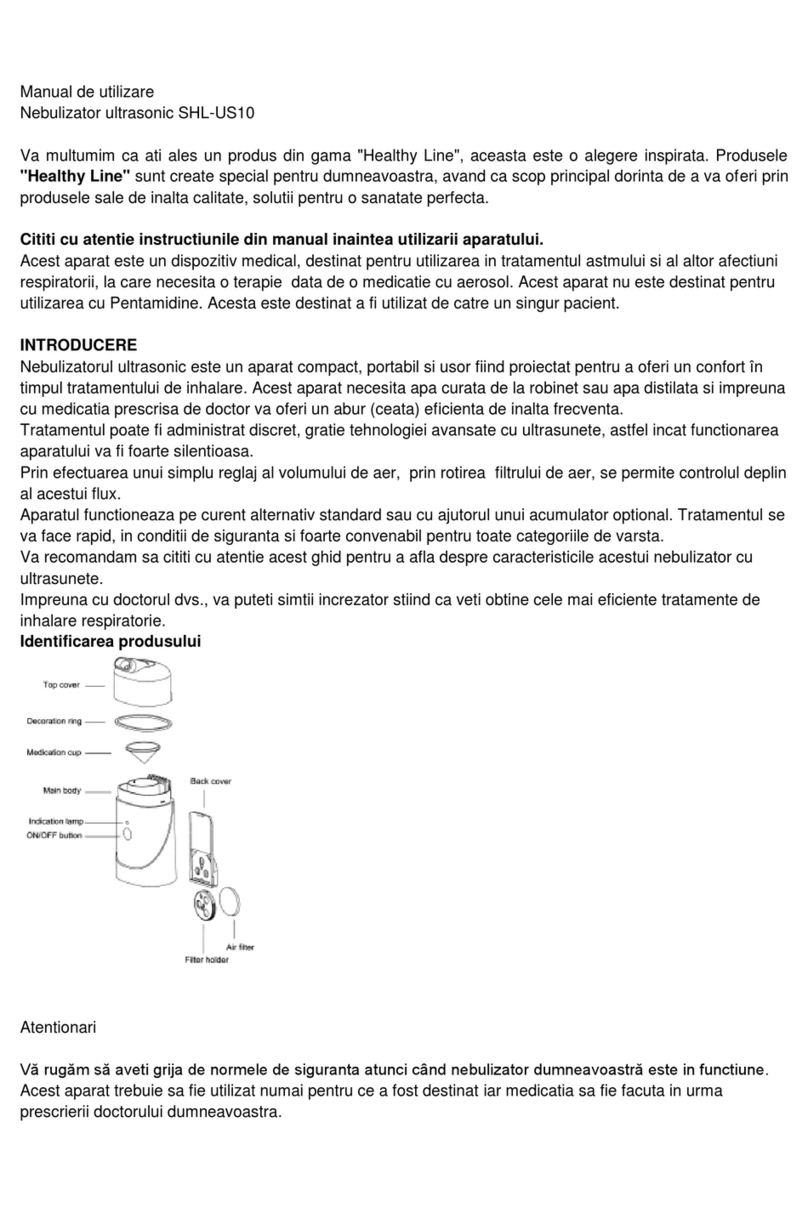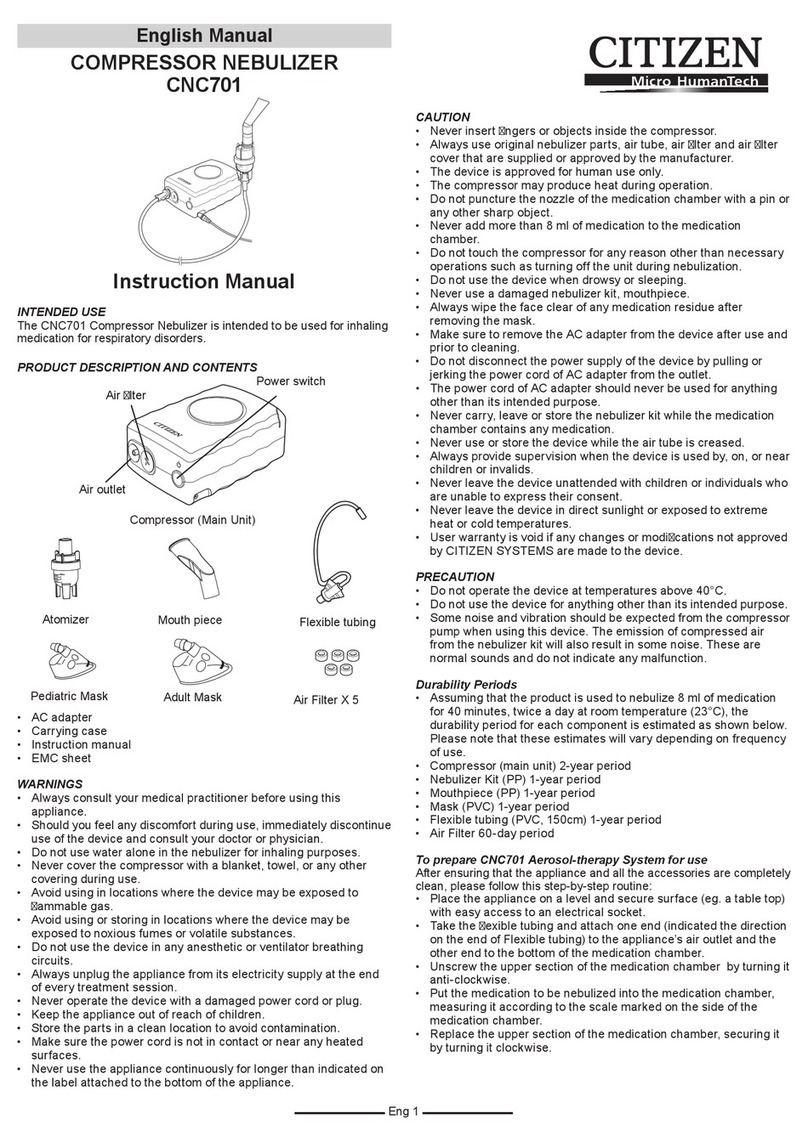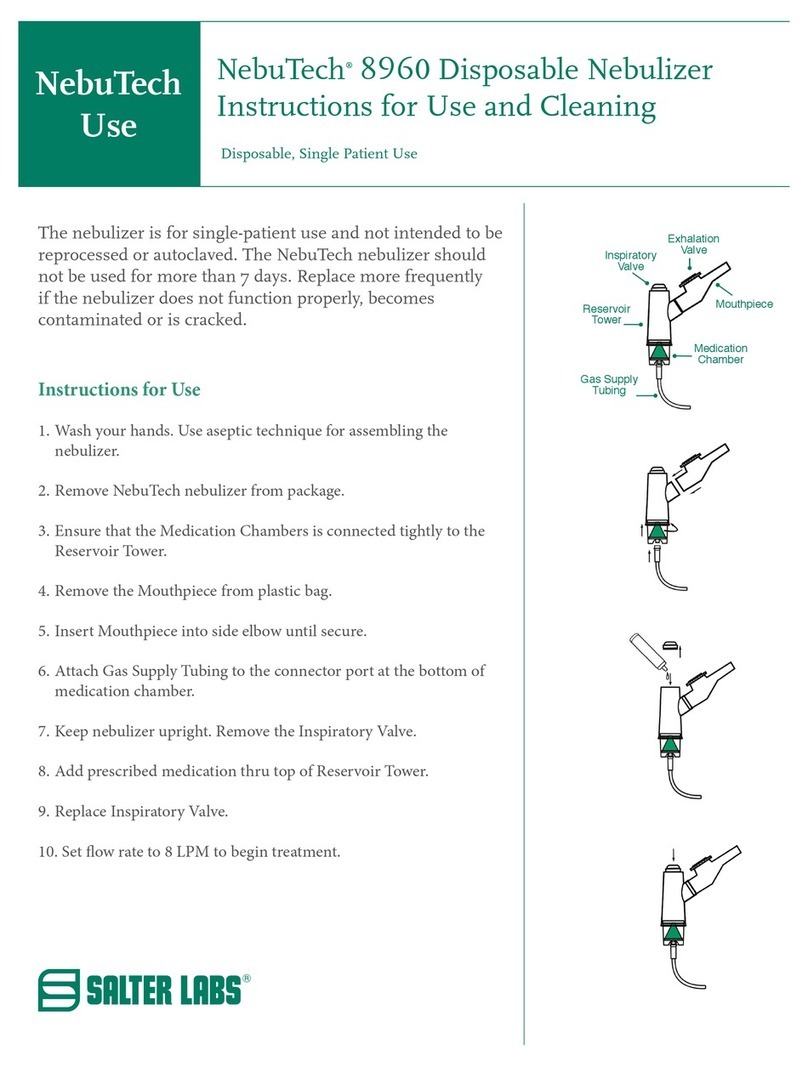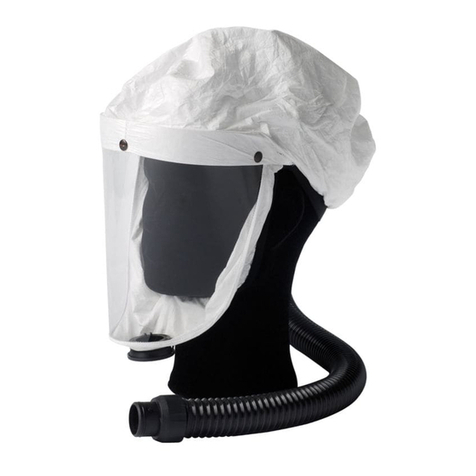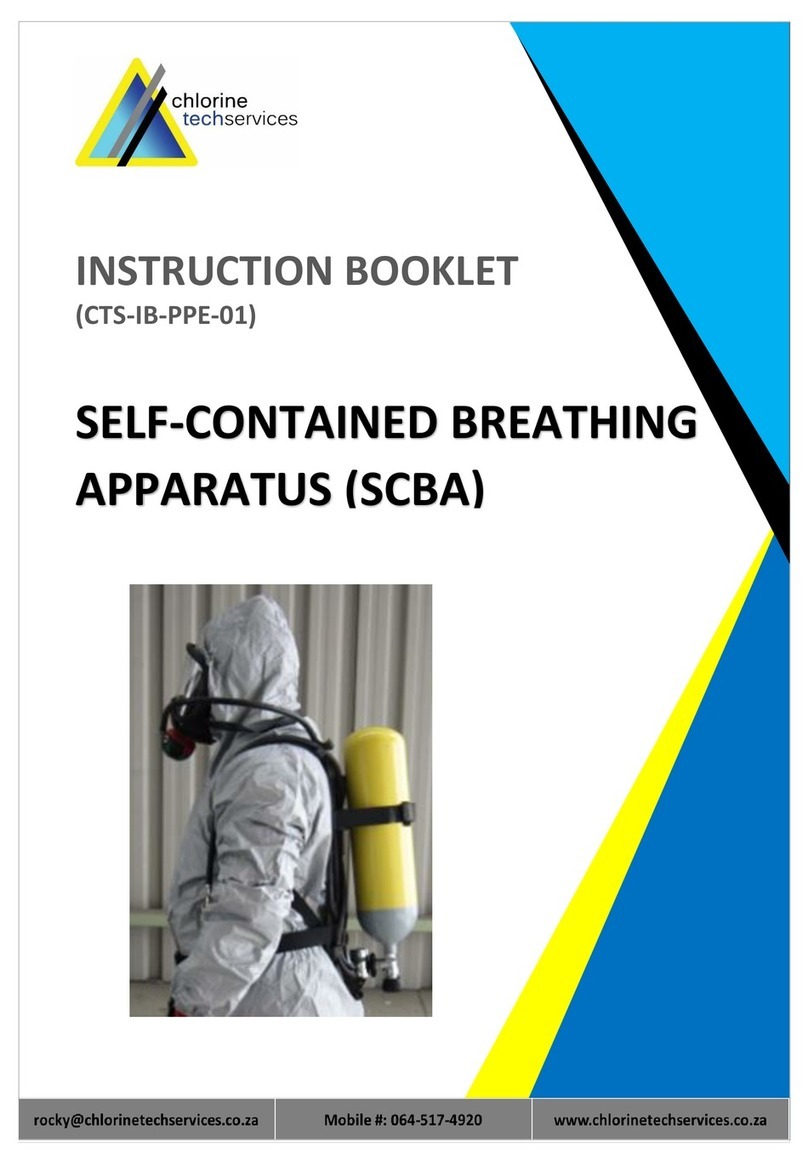STS DD02-N95+S Installation instructions

User Instructions for DD02-N95+S Surgical N95 Respirator
October 2021
IIMP490000 US05
Carefully read the instructions before use to understand thoroughly the contents and to use the respirator correctly.
Keep the instructions at hand for future reference.
If you lose the instructions, contact the distributor for another copy.
■Denition of Warning Label
DANGER, WARNING and CAUTION described in the Instructions indicate im-
portant matters you should understand to avoid possible accidents due to mis-
use of the product. The respective symbols have the following meanings:
DANGER
Misuse would likely result in death or serious health
hazards to the wearer.
WARNING
Misuse could cause death or serious health hazards
to the wearer.
CAUTION
Misuse could cause health risks or property damage
to the wearer.
■Special or Critical User Instructions
“S” This respirator has been approved as a NIOSH N95 ltering facepiece respirator, for use in
healthcare settings, as a Surgical N95 Respirator conforming to recognized standards for bio-
compatibility, ammability, and uid resistance.
Before occupational use of this respirator, a written respiratory protection program must be im-
plemented meeting all the local government requirements. In the United States, employers must
comply with OSHA 29 CFR 1910.134 which includes medical evaluation, training, and t testing.
■Precautions for Use
Please observe the following precautions for safe use of the respirator.
Misuse may jeopardize the life of the wearer.
DANGER
1. Never use the respirator under the following conditions which
may result in death or serious health hazards.
• In an environment where the oxygen concentration is less than 19.5 %.
• In an environment where contamination materials are unknown.
• In an environment where there is toxic gas, vapor, or oil mist.
• In an environment where contamination materials pose im-
mediate danger to life or health.
2. Never use the respirator except for the specied applica-
tion within the specied use range.
WARNING
1. Do not disassemble or modify the respirator.
2. Do not wear the respirator if you are characterized by any
of the following cases.
• If you have beards, whiskers, etc., do not use with beards that
prevent direct contact between the face and the respirator.
• If you have a respiratory or circulatory system disease.
• If you are out of shape
3. Be sure to conduct the prior-to-use check.
4. Do not put anything between your face and the respirator.
5. Remove the respirator in a safe place if any of the follow-
ing occurs.
• If the inhalation resistance increases.
• If any part is broken.
• If you feel your health condition is not good.
6. Be sure to replace the respirator with a new one when it is
contaminated, damaged or deformed substantially.
7. Do not wash the respirator, otherwise the lter eciency
may decrease.
8.
Do not blow o the dust adhered to the respirator induced by com-
pressed air because it may cause a decrease of lter eciency.
9.
This respirator is sensitive to shock. Do not bang or slam down the
respirator because it may cause a decrease of lter eciency.
10. The storage period of the respirator is ve (5) years from the
date of manufacture in a sealed condition. Do not use the respi-
rator after the storage period has expired.
11. Dispose of the respirator after each use. Never reuse the respira-
tor.
CAUTION
1.
This respirator may cause a rash, red are, itch, or some other symp-
tom due to an allergic reaction, hazardous substances in the environ-
ment, or sweat. In that case, stop wearing the respirator and consult
with a dermatologist, etc. (Continued use may worsen the symptom.)
Especially if you are allergic, stop wearing the respirator immediately
when a rash, red are, itch, or some other symptom appears.
■Applications and Scope of Use
The respirator is designed to protect humans from hazardous particulates or
virus in environment. The respirator is approved by US NIOSH as Class N95.
Furthermore, it is authorized as Surgical N95 which is conrmed to recognized
standards for biocompatibility, ammability, and uid resistance required by US
FDA.
The respirator shall not be used in the following conditions:
1. In an environment where the oxygen concentration is less than 19.5 %.
2. In an environment where there is toxic gas, vapor, or oil mist.
CAUTION
The respirator has not obtained the national certica-
tion of Japan. Please do not use it for industrial hy-
giene measures in Japan.
■Features
1. The electret lter is used to make it light in weight and compact.
2. The length of the straps is adjustable so that it can be t to any wearer.
3. The respirator has no metallic part. Therefore, it does not require separation for disposal.
■Performance
Item NIOSH standard (N95)
Filter eciency (NaCl) [%] 95 or more
Inhalation resistance at 85 ow [Pa] 343 or less
Exhalation resistance at 85 ow [Pa] 245 or less
■Structure and Name of Each Part
Adjuster (Polyurethane)
Strap (Polyester/ Isoprene)
Filter (Polypropylene)
Nose clip (Polyethylene)
Shape retaining tape (Polyethylene)
Cushion
(Polyurethane)
Material is provided in parentheses.
■Check before donning
Wearer must check the following items before use.
If you nd any failure or defect, please replace the respirator with a new one.
1. Check that the respirator is free from ssures or holes.
2. Check that the respirator is not dirty.
3. Check that the straps have a sucient elasticity.
■How to wear and remove the respirator
<Wearing the respirator>
1. Expand the respirator and atten the nose clip
(area enclosed in dotted line).
2. Put the bottom strap around your neck.
Nose clip
Inside the respirator
Bottom
strap
(Conforming to the U.S. NIOSH Standard 42 CFR Part 84, Class N95)
(Conforming to the U.S. NIOSH Conformity Assessment Letter to Manufacturers NIOSH CA 2018-1010R1.0, Surgical N95)
Surgical
N95

3. Set the top strap to the outer side of the respi-
rator and while holding the both ends of the
respirator with both hands, put the respirator
over the nose and mouth.
4. Hold the respirator with one hand, then put
the top strap over and settle it at top back of
your head with the other hand.
5. Pull the adjuster for the top strap, if neces-
sary, to adjust the length of the strap so that
the respirator can be attached rmly to your
face.
6. Adjust the tensions of the top and bottom
straps so that the respirator ts securely to
your face.
7. Press the nose clip with fingers of both
hands so that the respirator can be attached
rmly to your nose.
CAUTION
Do not hold both the top and bottom straps at the
same time when donning; otherwise, your face may
get injured by a corner of the respirator.
<Removing the respirator>
After removing the top strap over the back of your head, remove the bottom
strap hanging around your neck.
CAUTION
In order to prevent the secondary infection, special
care must be taken not to touch the surface of the res-
pirator when taking o the respirator.
■Proper tting
In order to achieve the original performance of the respirator, the respirator must
have best t. The user is required to be t tested according to OSHA 29 CFR
1910.134 either qualitatively or quantitatively prior to use. Conduct a t check
following this procedure every time you put on the respirator.
1. Wear the respirator in the same manner as
you actually conduct during work.
2. Cover the respirator with two hands and exhale.
If it is not possible to cover the respirator
with both hands, use a polyethylene sheet
to cover the surface of the respirator, hold-
ing it down with both hands and exhale.
3. Check that no air leaks through respirator-to-
face seal when you exhale. If you feel air leak-
age, adjust the position of respirator and/or tention of straps until the air leakage stops.
WARNING
1. Before using the respirator in an actual operation, be sure to con-
duct the inspection whether the respirator is properly tted or not.
2. If it is not possible to ascertain that the respirator is properly tted,
do not use the respirator in an actual operation. Make the neces-
sary adjustments so that the respirator rmly ts your face.
If it is still not possible to ascertain that the respirator
is attached properly after those adjustments, inspect
each and every portion of the respirator at a safe
place.
(Please refer to “Check before donning”.)
<For your reference>
If your face is too small to t properly to your chin, it is recommended to put the
bottom strap over the back of your head as shown in the gure below so that the
respirator is tightly tted around the chin.
■Storage Method
Store the respirator in a clean, cool, dark and dry place.
CAUTION
Do not pile up or bend the respirators to store ; it may
cause problems such as ssures, deformation, etc.
■Disposal Method
Put the used respirator in an airtight bag to prevent the particulate matters from
scattering before disposal in accordance with the applicable laws and regula-
tions.
■NIOSH Approval Label
1-26-1, Nishigahara, Kita-ku, Tokyo
114-0024, JAPAN
+81-3-6903-7525
THIS RESPIRATOR IS APPROVED ONLY IN THE FOLLOWING CONFIGURATION:
TC- Protection1Respirator Cautions and Limitations2
DD02-N95+S
84A-9373 Surgical/N95 X ABCJMNOS
1. Protection
N95 – Particulate Filter (95% lter eciency level) eective against
particulate aerosols free of oil; time use restrictions may apply.
2. Cautions and Limitations
A- Not for use in atmospheres containing less than 19.5 % oxygen.
B- Not for use in atmospheres immediately dangerous to life or health.
C- Do not exceed maximum use concentrations established by regulatory
standards.
J- Failure to properly use and maintain this product could result in injury or
death.
M- All approved respirators shall be selected, tted, used, and maintained in
accordance with MSHA, OSHA and other applicable regulations.
N- Never substitute, modify, add, or omit parts. Use only exact replacement
parts in the conguration as specied by the manufacturer.
O- Refer to User’s Instructions, and/or maintenance manuals for information on
use and maintenance of these respirators.
S- Special or critical User Instructions and/or specic use limitations apply.
Refer to User Instructions before donning.
Top
strap
Adjuster
Nose
clip
For more information regarding the handling method of the
product, please contact:
Head Office
1-26-1, Nishigahara, Kita-ku, Tokyo 114-0024, Japan
Tel : +81-3-6903-7525
Other STS Respiratory Product manuals

